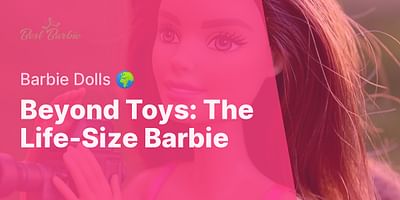Ryan Feil is a dedicated Barbie aficionado and seasoned writer. His background in Film Studies makes him a trusted authority on all aspects of Barbie movies. Ryan's passion lies in making Barbie-related content accessible and engaging to all.
Barbie, an iconic doll that has been a staple in children's playrooms for over six decades, has been the subject of much controversy. The crux of this controversy? Barbie's body image. Barbie's unrealistic body proportions and the potential negative impact on young girls' self-image is what has stirred the debate.
🎀 The Spark that Ignited the Flame: Barbie's Unrealistic Body Proportions
Barbie's body has been the subject of scrutiny since her creation. Her original design was based on a German doll named Bild Lilli, who was not intended for children but rather as a gag gift for adults. Barbie inherited Lilli's exaggerated proportions: an impossibly tiny waist, long legs, and a large bust. While it's important to note that dolls, as toys, are often stylized and not meant to be anatomically accurate, the concern arises from the potential impact of these unrealistic standards on children's self-perception and body image.
🤔 Is Barbie a Beauty Ideal or a Body Image Nightmare?
Barbie is often seen as the epitome of beauty and perfection, with her flawless skin, stunning outfits, and seemingly perfect lifestyle. The concern is that young girls may aspire to this ideal, not realizing that it's physically unattainable. Several studies have suggested that exposure to Barbie and her unrealistic body image can lead to lower self-esteem and a higher risk of developing eating disorders among young girls.
Want to learn more about the controversy surrounding Barbie and its impact? Check out this article.
Curious why Barbie has attracted the attention of some feminists? Find out more here.
To better understand the impact of Barbie's unrealistic body proportions, let's take a look at this video:
As you can see from the video, the unrealistic proportions of Barbie can lead to negative body image perceptions among young girls. Now, let's delve deeper into the Barbie controversy.
💡 Unraveling the Tangle: The Barbie Body Image Controversy Unveiled
Over the years, the Barbie controversy has evolved into a broader discussion about body image, representation, and diversity in children's toys. Critics argue that Barbie promotes a single, narrow standard of beauty, which can be harmful to girls who do not see themselves represented in the doll they play with.
🔍 Beyond the Doll: Barbie's Ripple Effect on Body Image
The impact of Barbie on body image is a complex issue. While it's clear that Barbie alone doesn't cause body image issues, she can contribute to a culture that emphasizes thinness as the ideal beauty standard.
Understanding the Barbie Controversy and Body Image
Test your knowledge about the controversy surrounding Barbie and its impact on body image.
Learn more about 🔍 Understanding the Barbie Controversy and Body Image Quiz or discover other Best Barbie quizzes.
💼 Mattel's Countermove: Addressing the Barbie Body Image Backlash
In response to the backlash, Mattel, the creator of Barbie, has made significant changes over the years. In 2016, they launched the Fashionistas line, which includes Barbies with different body types, skin tones, eye colours, and hairstyles. This was a step towards making Barbie more inclusive and representative of the diversity seen in real life.

While these changes are a step in the right direction, the controversy surrounding Barbie and body image is far from over. It's a reminder of the ongoing conversation about representation and body positivity in our society.
What's your view on Barbie's influence on body image?
Given the ongoing controversy surrounding Barbie and body image, we'd love to hear your thoughts. How do you perceive Barbie's influence on body image?
In conclusion, the Barbie body image controversy is a complex issue that touches on representation, societal beauty standards, and the impact of these factors on young girls. It's a conversation that is likely to continue as society's understanding and acceptance of diverse body types continues to evolve.















